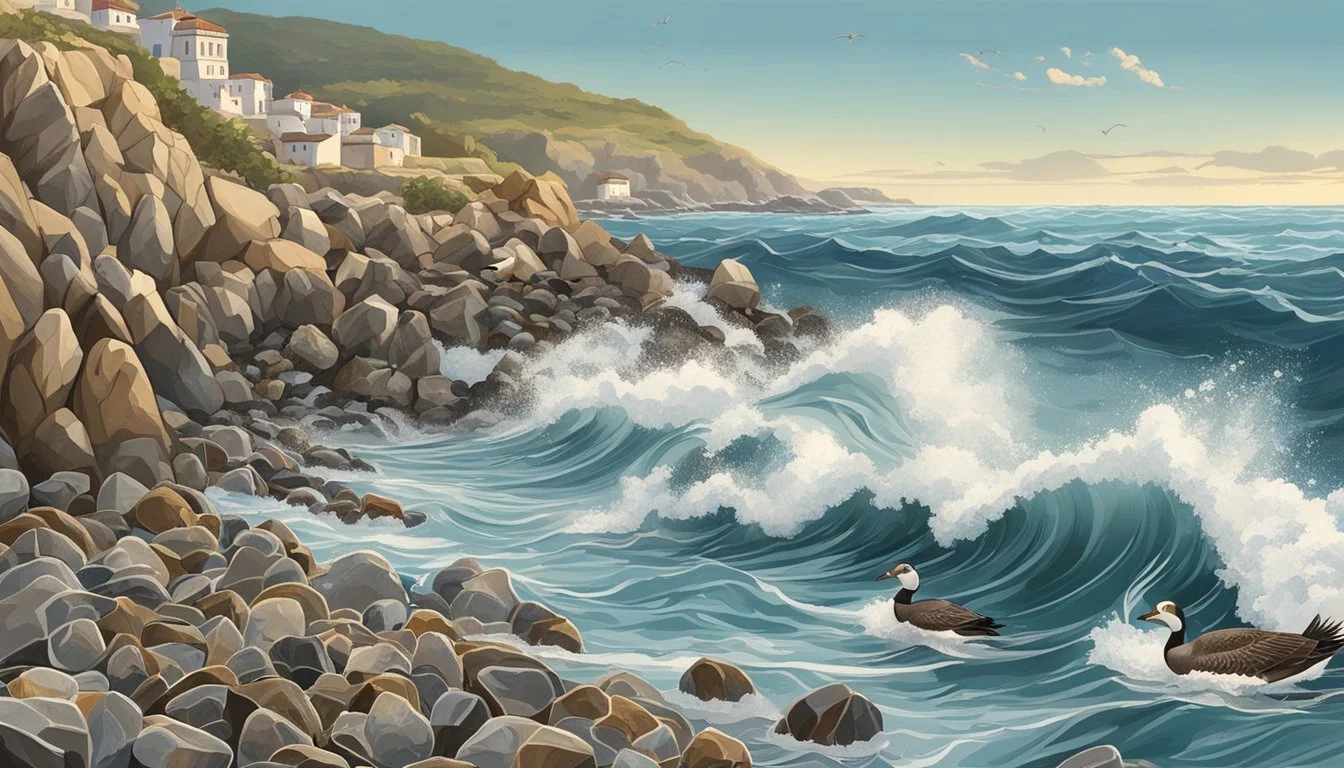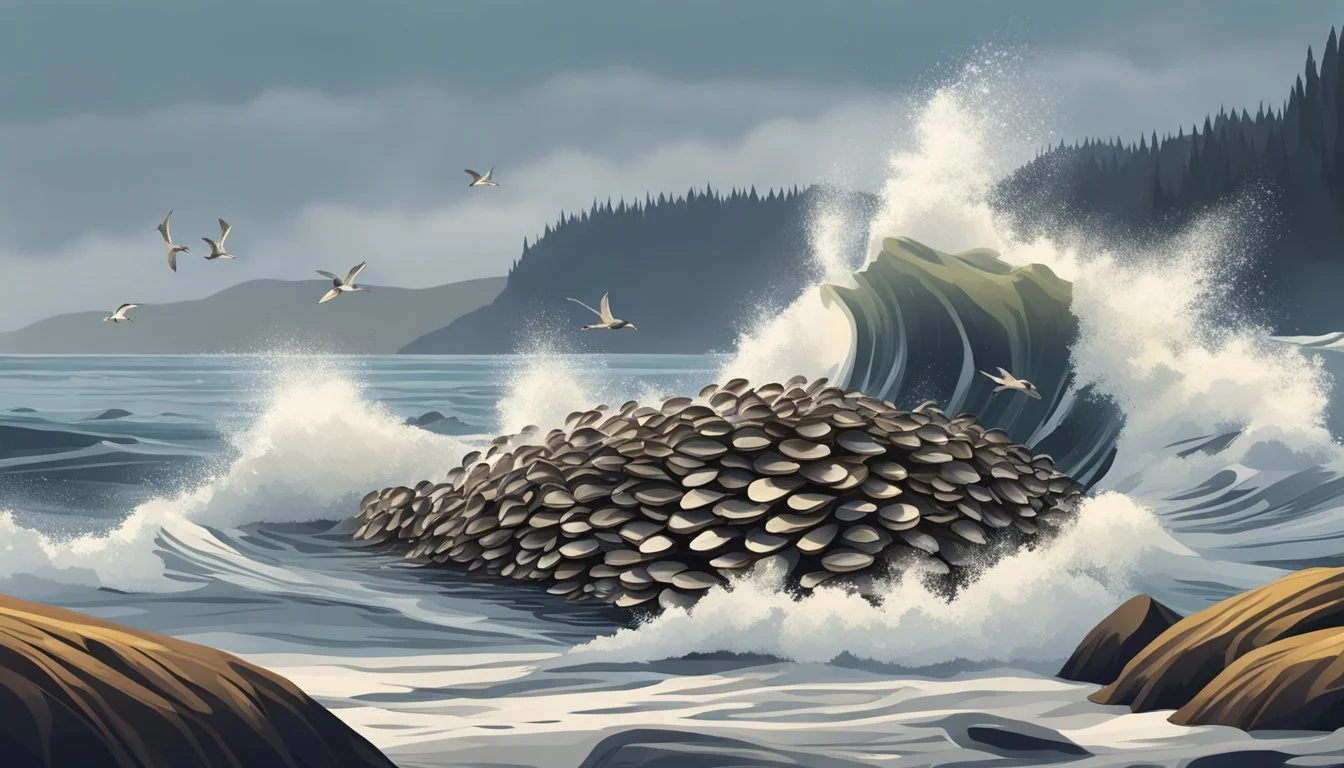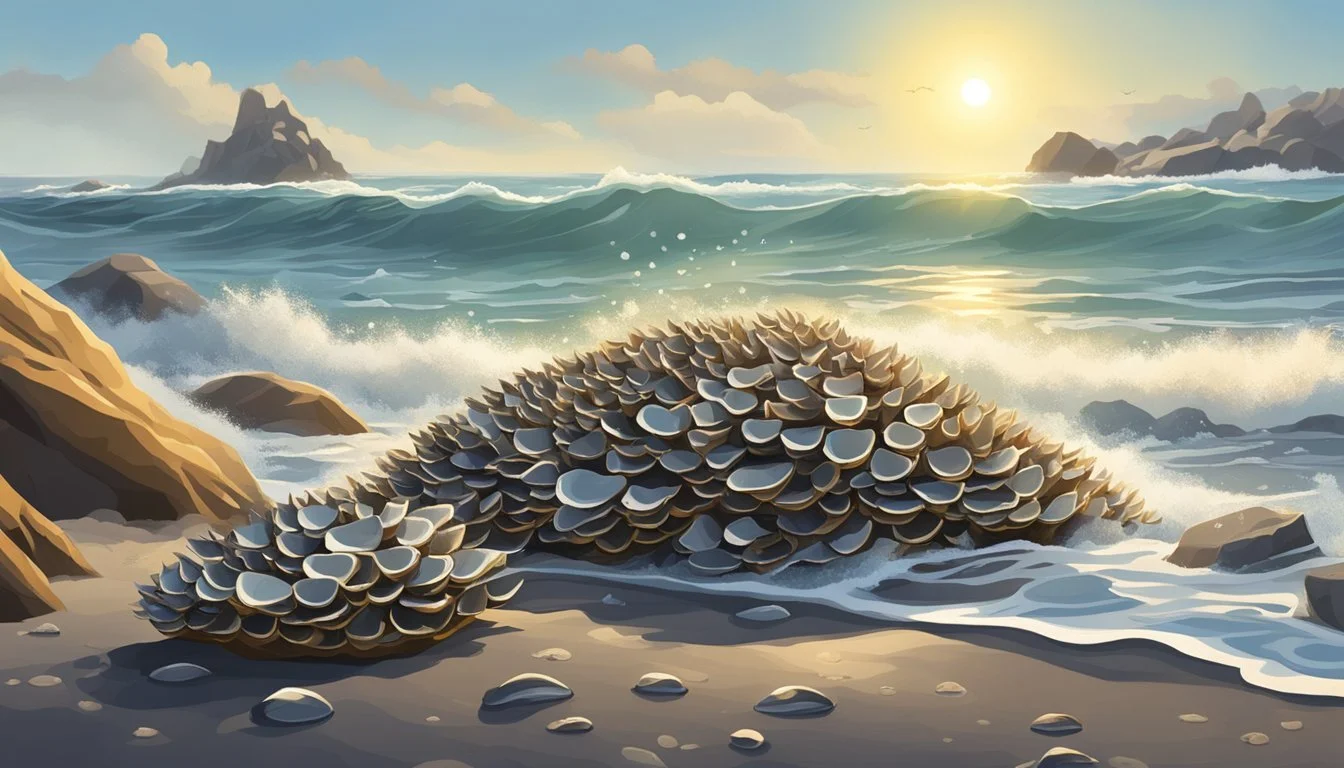Goose Barnacles Unveiling Iberia’s Coastal Delicacy
Goose barnacles, considered a rare delicacy in coastal Spain and Portugal, are a unique treasure of the seafood (What wine goes well with seafood?) world. Unlike common barnacles, the goose barnacle has a distinct appearance with its long, fleshy stalk and leathery cap, resembling the neck and head of a goose. These crustaceans attach themselves to the rocky substrates along the turbulent waters of the Iberian coast, where harvesting them is as perilous as it is laborious.
In the culinary scene of Spain and Portugal, goose barnacles, or "percebes," are highly esteemed, often fetching premium prices in the market. The traditional preparation is simple yet artful, preserving their intrinsic briny taste. Typically, they are briefly boiled in saltwater, enhancing their flavor with the very essence of the sea. Eaten warm, the succulent meat provides an unadulterated taste of the ocean, savored by seafood enthusiasts and considered a symbol of luxury dining.
Their scarcity and the risks involved in collecting them contribute to their exclusivity and high market value. The intertidal zones, where gooseneck barnacles thrive, are notoriously dangerous, making the occupation of barnacle harvesting both respected and revered. Despite these challenges, the continuous demand for this unique seafood sustains a long-standing tradition along the rugged coasts of Spain and Portugal, where goose barnacles remain a cultural and gastronomic highlight.
Biology and Identification
Goose barnacles, known scientifically as species within the order Pedunculata, exhibit a fascinating anatomy and play a distinct role in their coastal ecosystems. Their presence marks a unique culinary and biological significance along the rocky shores of Spain and Portugal.
Unique Anatomy of Goose Barnacles
The goose barnacle is immediately distinguishable by its peduncle, a flexible, stalk-like structure reminiscent of a goose’s neck, attaching the organism to hard substrates in the marine environment. The body of the barnacle, known as the capitulum, is encased in a protective shell. Within this shell, cirri, which are feathery appendages, emerge to capture plankton and organic material suspended in the water, showcasing their filter-feeding strategy. As crustaceans, goose barnacles undergo a planktonic larval stage before settling and becoming sessile adults.
Percebes in the Ecosystem
As a part of the intertidal zone's ecosystem, goose barnacles (or percebes in Spanish and Portuguese) are prominent. They attach to rocks, ships, and flotsam, often in dense clusters, and are integral to nutrient cycling due to their filter-feeding behavior. By extracting plankton from the water, they help to maintain the balance of marine microorganisms and are, in turn, a food source for other species, including humans.
Geographic Distribution and Habitat
Goose barnacles, symbols of marine resilience, thrive on the rugged coasts of Spain and Portugal, where waves continuously renew their nutrient-rich habitat.
Goose Barnacles on Iberian Coasts
The Iberian Peninsula, particularly the coastal regions of Galicia, the Basque Country, and Asturias in Spain, alongside the rocky shores of Portugal, offers an ideal habitat for goose barnacles. In these areas, barnacles anchor themselves onto the rocks within the intertidal zone. The strength of the ocean’s waves and the availability of nutrients make these zones perfect for goose barnacles' growth and abundance. They are especially prevalent in the Galician region, known as a barnacle hotspot.
Spain: Recognized for clusters of goose barnacles, Northern Spain's Galicia and the Basque Country navigate the culinary spotlight with this seafood.
Portugal: Joining Spain, Portugal's coastline supports rich goose barnacle populations, continuing the Iberian tradition of barnacle harvesting.
Beyond the Iberian Peninsula: Global Presence
While the Iberian coasts are notable for their goose barnacle populations, these crustaceans are also found globally. They occupy similar ecological niches in areas where the intertidal zones provide similar rugged and nutrient-rich environments.
Canada: On the other side of the Atlantic, Canadian coasts also witness the growth of goose barnacles, sharing ecological conditions akin to those of Iberia.
The presence of goose barnacles is thus not limited to the Iberian Peninsula, although it is here that they have garnered cultural and culinary significance.
Culinary Tradition
Gooseneck barnacles, known as percebes in Spain and Portugal, are a celebrated seafood delicacy in these coastal nations. Their unique flavor and texture, coupled with the knowledge required for their preparation, underscore their esteemed status in local culinary traditions.
The Delicacy of Percebes in Spain and Portugal
Percebes are highly prized for their distinctive taste that reflects the essence of the sea. This delicacy thrives on the rugged, rocky coastlines of Spain and Portugal, particularly in the regions of Galicia and the northern provinces of Spain, as well as along the Portuguese coastline. The harvesting process is treacherous, adding to the percebes' value and rarity. Locals and tourists alike often indulge in this delicacy at regional restaurants, where they are consumed as a symbol of coastal cuisine.
Taste Profile: Succulent with a briny, slightly sweet flavor
Primary Regions: Galicia (Spain), Coastal Portugal
Rareness: Difficult and dangerous to harvest
Preparing Goose Barnacles: Methods and Recipes
Cooking percebes requires a minimalist approach to preserve their natural flavors. The standard method involves boiling them briefly in salted water, often infused with bay leaf and a splash of white wine, to accentuate their oceanic taste. This simple preparation allows the delicate texture and robust flavor of the goose barnacles to shine.
Standard Cooking Procedure:
Clean the percebes thoroughly in fresh water.
Bring a large pot of brine (water and generous amounts of sea salt) to a rolling boil. Optional additions may include a bay leaf to impart additional flavor.
Submerge the percebes and boil for just a few minutes—they cook quickly and overcooking will diminish their quality.
Serve the steamed percebes warm, paired with a crisp, cold beverage or a glass of white wine.
Serving Suggestions:
Method: Typically boiled, optional to steam
Seasoning: Bay leaf, white wine
Presentation: Serve warm on a plate, often with no additional condiments to allow natural flavors to dominate
Sustainable Harvesting and Economy
In the realm of seafood treasures, the goose barnacle holds a significant place within the economies of Spain and Portugal, specifically relying on a sustainable balance of harvesting practices to maintain both ecological stability and the livelihood of coastal communities.
The Role of Percebeiros
Percebeiros, as they are known in Spain, form the backbone of the marine harvesting tradition along the Galician coast. These specialized harvesters brave the dangers of the sea, often climbing down steep cliffs and working amidst treacherous waves to collect goose barnacles. Equipped with chisels and anchors, percebeiros execute their task with precision, ensuring the quality and sustainability of their catch. Their expertise not only minimizes harm to the marine ecosystem but also guarantees the survival and regeneration of barnacle populations.
Percebeiro's equipment:
Chisels: For detaching barnacles
Anchors: To stabilize on rocky surfaces
The dangerous nature of their work and the skill required to perform it justifies the premium prices of goose barnacles, which, in turn, supports the percebeiros' livelihoods. The harvesting is stringently regulated, with policies in place to enforce rest periods for regeneration and size limits to prevent the capture of juvenile barnacles.
Market Demand and Economic Impact
The market for goose barnacles is competitive, with demands peaking for this delicacy during special occasions and holidays. In regions like Galicia, the sale of barnacles holds considerable economic weight, contributing to about 2.5% of total extractive marine species sales. Restaurants and consumers prize goose barnacles for their freshness and unique taste, making them an esteemed product in the seafood market.
Economic impact in Galicia:
Contribution: 2.5% of marine species sales
Consumed mostly: Fresh
Despite the high market demand, sustainability remains central to the business of barnacle fishing, where the balance between economic prosperity and environmental health is continually sought after. The ongoing effort to improve the marketing strategies of Galician seafood is a testament to the region's commitment to sustainable practices. Consequently, these endeavors support both the local marisqueira (shellfish gatherers) and maintain the high regard that Spanish and Portuguese goose barnacles hold on a global scale.
Conservation and Management
The conservation and management of goose barnacle populations are critical due to their ecological significance and economic value. Sustainable practices ensure the long-term viability of this resource.
Protecting Goose Barnacle Populations
In Spain's Basque Country, marine protected areas like the Gaztelugatxe Marine Reserve, which spans 158 hectares, have been established to aid in the recovery of Pollicipes pollicipes populations. After years of legal protection, these reserves demonstrate a positive trend in the conservation of goose barnacles, which are often found clustered on rocks during low tide.
Regulations and the Future of the Industry
Strict regulations are in place to support sustainable goose barnacle harvesting, especially in regions where their rarity makes them a valuable delicacy. These regulations include:
Seasonal Restrictions: Harvesting is limited to certain times of the year to prevent overexploitation.
Size Limits: Minimum sizes ensure only mature barnacles are collected, safeguarding the breeding population.
Permitted Areas: Harvesting is allowed in designated zones, with several areas left untouched to serve as conservation sites.
These measures aim to strike a balance between the demands of the seafood industry and the necessity of preserving marine ecosystems. The future of the industry relies on the continued enforcement of these regulations, coupled with community awareness and scientific monitoring.
Cultural Significance
The goose barnacle holds a prestigious status in the cultural and gastronomic heritage of Spain and Portugal, particularly within regions like Galicia and the Basque Country. This rare crustacean has not only influenced the local cuisine but also spurred tourism, tying deeply into the coastal way of life.
Goose Barnacles in Local Culture
In Galicia, the percebe, as it is known in Spanish, is a symbol of local identity and tradition. The harvesting of goose barnacles is a perilous job that requires percebeiros (barnacle fishers) to navigate treacherous waters against jagged rocks, often amid powerful waves. This dangerous endeavor imbues the barnacle with a sense of reverence and pride among locals. It is common for families and communities to gather and enjoy goose barnacles during festivals and holidays, marking it as a celebratory food intertwined with the region's social fabric.
Influence on Gastronomy and Tourism
Goose barnacles have a profound influence on culinary traditions, with their unique flavor and texture elevating them to a delicacy status in both Spain and Portugal. In the Basque Country, they are a sought-after ingredient featured prominently on restaurant menus, fostering a gastronomic attraction that draws visitors to the region. Similarly, the coastal areas around Lisbon, known for their excellent surf, also boast restaurants where the barnacle is a luxurious highlight. Tourists are often intrigued by the exclusivity and expense of the barnacle, making it a flagship representation of the regions' seafood offerings.
Notable Dishes and Preparations:
Boiled and served with a touch of sea salt
Paired with other local seafood, such as clams (What wine goes well with clams?)
Tourism Facets:
Culinary tours and experiences centered around seafood sampling
Visits to the perilous coastal areas where barnacles are harvested
The presence of the goose barnacle on menus serves as an ambassador for the regional seafood cuisine, contributing significantly to an enduring culinary legacy and providing a boost to the local economies through gastronomy-inspired travel.
Enjoying Goose Barnacles Safely
When indulging in goose barnacles, ensuring safety and quality is paramount. Consumers should follow specific guidelines and prioritize freshness to fully appreciate this unique shellfish.
Guidelines for Consumers
Consumers must be discerning when selecting goose barnacles to ensure they are consuming them safely. Here are key steps to take:
Purchase from Reputable Sources: Always buy goose barnacles from trusted restaurants or markets known for handling shellfish properly.
Inspect the Barnacles: Fresh goose barnacles should have a moist appearance and a sea-breeze scent. Their stalks should be firm, and the shells tightly closed.
Proper Storage: If not consumed immediately, store them in a cold environment, between 0°C and 5°C, and consume within 24 hours for optimal quality.
Cooking Method: Boil the goose barnacles in salted water for a few minutes until the flesh is tender—this simplicity in cooking allows their natural flavor to shine.
The Importance of Quality and Freshness
Quality and freshness are critical when consuming goose barnacles, similar to enjoying a fine lobster. The key components of quality include:
Live Product: High-quality goose barnacles are often sold live, which signifies peak freshness.
Texture and Taste: A fresh goose barnacle has a texture akin to squid or octopus, and the taste should be reminiscent of the ocean, without any hint of fishiness.
Adhering to these guidelines ensures that consumers enjoy goose barnacles in their best and safest form.







